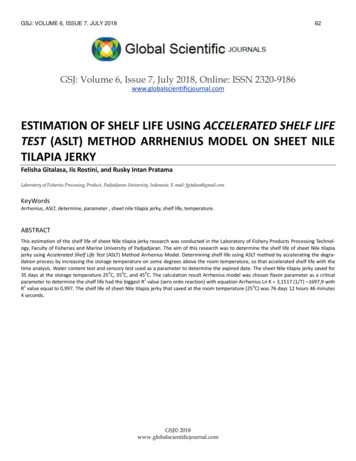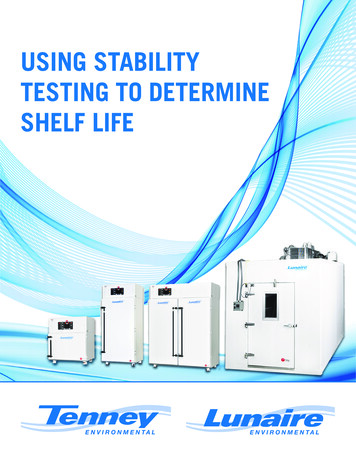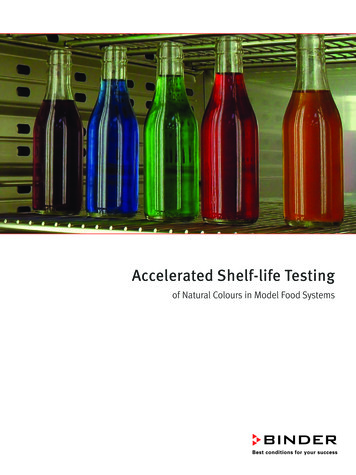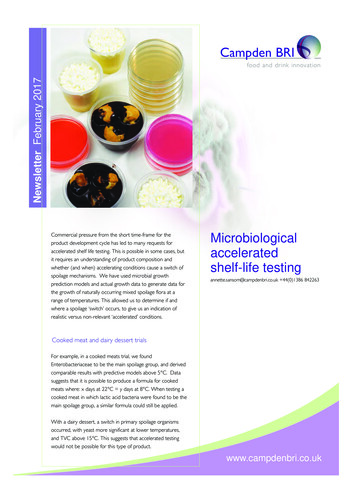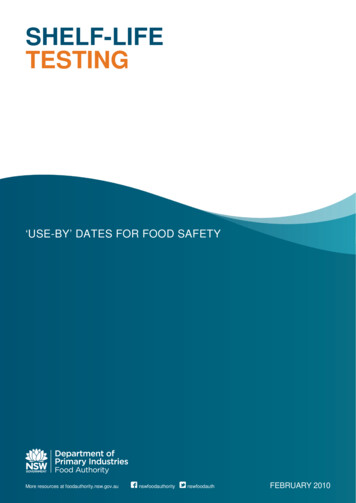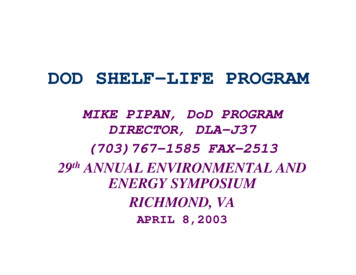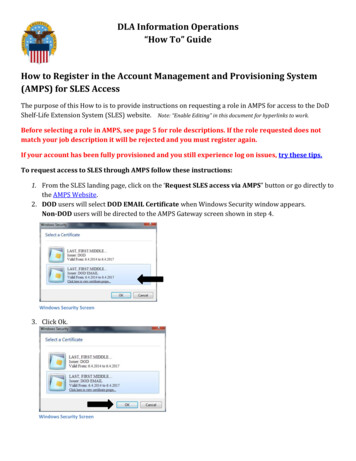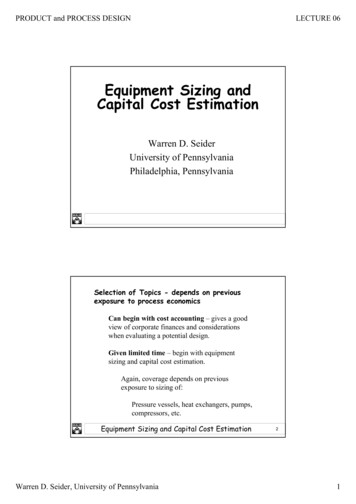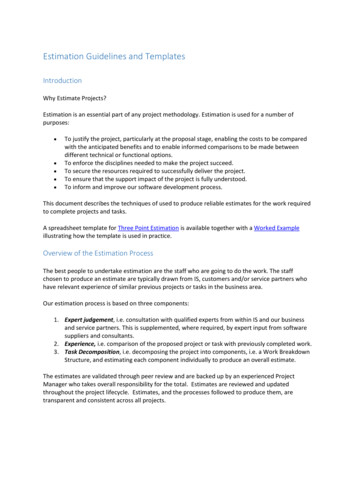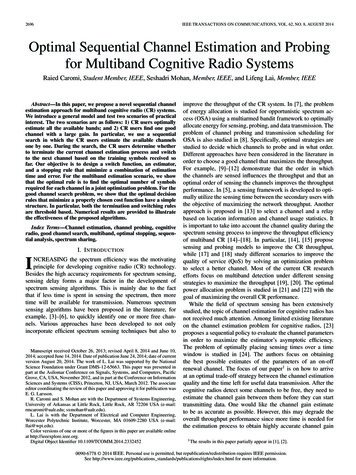
Transcription
Stability and shelf life estimationYossi LevyRegulatory background 6 guidelines (Q1A-Q1F) cover all aspects of stability andshelf life estimation Two of them are relevant for statisticians Q1A - Stability Testing of New Drug Substances andProducts Q1E - Evaluation of Stability Data2 Yossi Levy 2011
What is shelf life?Labeled shelf-life provides the consumer theconfidence that the drug product will retain its identity,strength, quality, and purity throughout the expirationperiod of the drug productChow, 2007The maximum time at which a stability limitingcharacteristic stays within acceptance criteriaICH Q1A3Shelf life – statistical definitionThe maximum time at which the true mean response ofa stability limiting characteristic crosses the acceptancecriterionICH Q1A4 Yossi Levy 2011
The statistical paradigm5The statistical challenge The true mean response is not known But it can be estimated How?6 Yossi Levy 2011
The simple experimental design Put the product on the shelf Measure its stability indicating characteristics once in awhile Estimate the response line, e.g. using linear regression7Extended paradigm8 Yossi Levy 2011
What should be modeled? Individual tablets (syringes/etc.)? Composite sample of several tablets? Packaged unit (bottle or blister pack)? Batches? Special stability batches or all future batches?9Design considerations Effect of environmental factors – temperature, humidity, etc. Effect of packaging type – bottles, blisters, etc. Effect of dose – usually can be combined into one study, ifformulations are similar10 Yossi Levy 2011
Storage conditions Storage conditions reflect the environmental factors Three levels Recommended storage conditions (e.g. roomtemperature) Intermediate storage conditions Accelerated storage conditions11Recommended conditions E.g. room temperature: 25oC/60%RH Long term testing – up to the desired shelf life, and maybebeyond that Test frequency 1st year – every three months 2nd year – every six months Thereafter - annually12 Yossi Levy 2011
Accelerated conditions E.g. 40oC/75%RH Designed to increase the rate of chemical degradation orphysical change Test duration – 6 months At least 3 time points are required Stability in 6 months of accelerated storage conditionssupports 2 years of shelf life in recommended storageconditions13Accelerated conditions significantchange 5% change in assay value from its initial value Any degradation product exceeding its acceptance criterion Failure to meet acceptance criteria for stability indicatingcharacteristics14 Yossi Levy 2011
Intermediate conditions E.g. 30oC/65%RH Triggered when a significant change is observed inaccelerated conditions Testing time points: time zero, and from point of significantchange onward15Statistical evaluation Not always needed – sometimes it suffices just to presentthe graphs Needed when The company wishes to pool data from several batches The company wishes to extrapolate the shel life beyondthe test period Bad things happen 16 Yossi Levy 2011
Simple linear model YT the measured parameter at time T T time (typically measured in months) Model:YT β 0 β1 T ε17Design issues What would be the “sample size”? Are statistical assumptions valid? Distribution Independence Homogeneity18 Yossi Levy 2011
ICH methodology Minimum of three batches Batches are considered as fixed effects Data from batches can be pooled if there are no significantdifferences between batches Shelf life is determined by crossing point of acceptancecriterion and 95% confidence interval for the mean19Specification checking For an attribute known to decrease with time, the lowerone-sided 95 percent confidence limit should be comparedto the acceptance criterion For an attribute known to increase with time, the upper onesided 95 percent confidence limit should be compared tothe acceptance criterion For an attribute that can either increase or decrease, orwhose direction of change is not known, two-sided 95percent confidence limits should be calculated andcompared to the upper and lower acceptance criteria20 Yossi Levy 2011
Multiple batches Each batch can be analyzed separately – but then the shelflife is determined by the “worst case” Or we can analyze data from all batches in one model,controlling for the batch as a covariate21Model for multiple batches YTB the measured parameter from batch B at time T T time (typically measure in months) B the batch B*T batch and time interaction Model:YTB β 0 β1 T β 2 B β 3 T B ε22 Yossi Levy 2011
Four models1. Unequal intercepts and slopes (β2 0 and β3 0) Analyzeeach batch separately2. Common intercept, unequal slopes (β2 0 and β3 0) – notallowed by ICH3. Unequal intercepts, common slope (β2 0 and β3 0)4. Common intercept and slope (β2 β3 0) – pooled analysis23Model selection procedure1. Test H0: β3 0. If rejected – analyzed each batch separately2. If H0: β3 0 is not rejected, then test H0: β2 0a) If rejected, use parallel slope modelb) Otherwise, all batches can be pooledThese tests can be performed at a significance levelof α 0.2524 Yossi Levy 2011
Example 1 - poolability test25Example 1 - Analysis26 Yossi Levy 2011
Example 1 - Specification checking27Example 2 - poolability test28 Yossi Levy 2011
Example 2 - Analysis29Example 2 - Specification checking30 Yossi Levy 2011
Example 3 - poolability test31Example 3 - Analysis32 Yossi Levy 2011
Example 3 - Specification checking33 Yossi Levy 2011
Accelerated conditions E.g. 40 oC/75%RH Designed to increase the rate of chemical degradation or physical change Test duration – 6 months At least 3 time points are required Stability in 6 months of accelerated storage conditions supports 2 years of shelf life in recommended storage conditions 14 Accelerated conditions significant change
